In Greenpoint, Brooklyn, Manhattan Avenue--one of the neighborhood's main throughfares--dead-ends at Newtown Creek. One recent year, the Environmental Protection Agency declared it the nation's most polluted body of water. (In other years, the Gowanus Canal has garnered that distinction.) But when it doesn't win "the Prize", the Creek is almost always listed among the most polluted bodies of water in the nation.
Of course, I don't think about that when a late day ride takes me there and I take in the views.
There's a nature walk along the creek. By its side, at the end of Manhattan Avenue, there's a green patch with a fence around it that's a popular place to lock--and, it seems, abandon--bicycles.
Sometimes the bikes left there are rather interesting in their own ways. For instance, there was this Ross 3-speed:
Ross was known mainly for making "muscle" bikes like the Barracuda (which was intended to compete with the likes of the Schwinn Krate and Raleigh Chopper) and some of the early production mountain bikes. Their factories were located in Rockaway Beach, NY and Allentown, PA, before production moved to Taiwan.
However, during the 1960s--on the eve of the North American Bike Boom--Ross imported three-speed bikes from Japan. At that time, few Americans owned or rode bikes with derailleurs. Thus, most adults who rode--and kids who wanted something lighter than the baloon-tired "bombers" made by Schwinn and other American companies--preferred three-speed bikes, which were called "English racers".
Most of those bikes were made by the likes of Dunelt, Sunbeam, Robin Hood and other companies--and, of course, Raleigh, which would later acquire most of those marques and all but monopolize the remaining market for that type of bicycle.
However, as demand grew, those old English manufacturers couldn't keep up. Thus, bikes were imported from Japan. One of my first bikes--a Royce-Union--was one of those English-style Japanese three-speeds. As you can see in the photos, bike-makers in the Land of the Rising Sun did everything they could to emulate, if only visually, the "English Racers" that were so popular in the US and elsewhere.
(When Centurion ten-speeds first came to these shores in 1969, they could very easily be mistaken for Raleigh Grand Prix machines of the same year--unless, of course, one noticed the SunTour or Shimano derailleurs, as well as a few other details. At that time, most Raleighs came with Simplex or Huret derailleurs.)
Some Japanese bikes came with leather saddles, also made in Japan, that resembled the offerings of Brooks, Ideale and other British and European makers. I don't know whether the bikes made for Ross came with them (I can find practically no information about the bikes), but somehow I doubt it. Even if it came with a leather saddle, I doubt it would have been this one:
You probably think it's a beat-up Brooks B72: the saddle that came with many British three-speeds. It does indeed have the same looped under-carriage rails and saddlebag slots built into the saddle. And the top is the same size, and has the same shape as the B72, with a couple of exceptions:
It is indeed a B18. The embossed floral pattern at the top is wearing down. I don't know whether it's from use or abandonment. Somehow I don't think it's an original-production B18 from the 1930s, worn as it is. The design was resurrected about a decade ago, as classic-style ladies' city bikes became popular. The curled front is designed to prevent a skirt from getting caught on the saddle.
Whatever the story, the saddle is a nice addition to the bike, though I think it deserves better than to have bird poop on it. I have to wonder, though, how the bike rides with this bar and stem combination:
That extension of that stem must be about 120mm. That makes the steering more sensitive. And, of course, the bars increase leverage. I would be curious to ride the bike just to see how a bike that's not made for quick cornering rides with touchy steering. Maybe it's a good combination for riding in traffic.
Anyway, I hope the bike isn't abandoned. It may not be anyone's idea of a "great" or "classic" bike. But it certainly is practical (except for those bars!) and I am always glad to see a bike like it in circulation. At least, I hope, it won't become part of the detritus in Newtown Creek!
Of course, I don't think about that when a late day ride takes me there and I take in the views.
There's a nature walk along the creek. By its side, at the end of Manhattan Avenue, there's a green patch with a fence around it that's a popular place to lock--and, it seems, abandon--bicycles.
Sometimes the bikes left there are rather interesting in their own ways. For instance, there was this Ross 3-speed:
Ross was known mainly for making "muscle" bikes like the Barracuda (which was intended to compete with the likes of the Schwinn Krate and Raleigh Chopper) and some of the early production mountain bikes. Their factories were located in Rockaway Beach, NY and Allentown, PA, before production moved to Taiwan.
However, during the 1960s--on the eve of the North American Bike Boom--Ross imported three-speed bikes from Japan. At that time, few Americans owned or rode bikes with derailleurs. Thus, most adults who rode--and kids who wanted something lighter than the baloon-tired "bombers" made by Schwinn and other American companies--preferred three-speed bikes, which were called "English racers".
Most of those bikes were made by the likes of Dunelt, Sunbeam, Robin Hood and other companies--and, of course, Raleigh, which would later acquire most of those marques and all but monopolize the remaining market for that type of bicycle.
However, as demand grew, those old English manufacturers couldn't keep up. Thus, bikes were imported from Japan. One of my first bikes--a Royce-Union--was one of those English-style Japanese three-speeds. As you can see in the photos, bike-makers in the Land of the Rising Sun did everything they could to emulate, if only visually, the "English Racers" that were so popular in the US and elsewhere.
(When Centurion ten-speeds first came to these shores in 1969, they could very easily be mistaken for Raleigh Grand Prix machines of the same year--unless, of course, one noticed the SunTour or Shimano derailleurs, as well as a few other details. At that time, most Raleighs came with Simplex or Huret derailleurs.)
You probably think it's a beat-up Brooks B72: the saddle that came with many British three-speeds. It does indeed have the same looped under-carriage rails and saddlebag slots built into the saddle. And the top is the same size, and has the same shape as the B72, with a couple of exceptions:
It is indeed a B18. The embossed floral pattern at the top is wearing down. I don't know whether it's from use or abandonment. Somehow I don't think it's an original-production B18 from the 1930s, worn as it is. The design was resurrected about a decade ago, as classic-style ladies' city bikes became popular. The curled front is designed to prevent a skirt from getting caught on the saddle.
Whatever the story, the saddle is a nice addition to the bike, though I think it deserves better than to have bird poop on it. I have to wonder, though, how the bike rides with this bar and stem combination:
That extension of that stem must be about 120mm. That makes the steering more sensitive. And, of course, the bars increase leverage. I would be curious to ride the bike just to see how a bike that's not made for quick cornering rides with touchy steering. Maybe it's a good combination for riding in traffic.
Anyway, I hope the bike isn't abandoned. It may not be anyone's idea of a "great" or "classic" bike. But it certainly is practical (except for those bars!) and I am always glad to see a bike like it in circulation. At least, I hope, it won't become part of the detritus in Newtown Creek!











